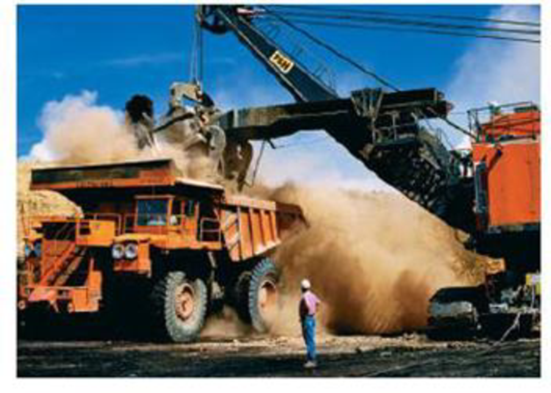
EBK PHYSICS
5th Edition
ISBN: 8220103026918
Author: Walker
Publisher: PEARSON
expand_more
expand_more
format_list_bulleted
Textbook Question
Chapter 8, Problem 8CQ
Discuss the nature of the work done by the equipment shown in this photo. What types of forces are involved?

Conservative or nonconservative? (Conceptual Question 8)
Expert Solution & Answer
Want to see the full answer?
Check out a sample textbook solution
Students have asked these similar questions
Imagine you are out for a stroll on a sunny day when you encounter a lake. Unpolarized light from the sun is reflected off the lake into your eyes. However, you notice when you put on your vertically polarized sunglasses, the light reflected off the lake no longer reaches your eyes. What is the angle between the unpolarized light and the surface of the water, in degrees, measured from the horizontal? You may assume the index of refraction of air is nair=1 and the index of refraction of water is nwater=1.33 . Round your answer to three significant figures. Just enter the number, nothing else.
Deduce what overvoltage is like in reversible electrodes.
pls help on these
Chapter 8 Solutions
EBK PHYSICS
Ch. 8.1 - 1. In Figure 8-8, the work done by a conservative...Ch. 8.2 - 1. The work done by a conservative force on a...Ch. 8.3 - A system with only conservative forces acting on...Ch. 8.4 - 4. A system is acted on by more than one force,...Ch. 8.5 - A system consists of an object moving along the x...Ch. 8 - Is it possible for the kinetic energy of an object...Ch. 8 - If the stretch of a spring is doubled, the force...Ch. 8 - When a mass is placed on top of a vertical spring,...Ch. 8 - If a spring is stretched so far that it is...Ch. 8 - An object is thrown upward to a person on a roof....
Ch. 8 - It is a law of nature that the total energy of the...Ch. 8 - Discuss the venous energy conversions that occur...Ch. 8 - Discuss the nature of the work done by the...Ch. 8 - It the force on an object is zero, does that mean...Ch. 8 - When a ball is thrown upward, its mechanical...Ch. 8 - When a ball is thrown upward, it spends the same...Ch. 8 - The work done by a conservative force is indicated...Ch. 8 - 2. Calculate the work done by gravity as a 3.2-kg...Ch. 8 - Calculate the work done by friction as a 37-kg box...Ch. 8 - Predict/Calculate A 2.8-kg block is attached to a...Ch. 8 - Predict/Calculate (a) Calculate the work done by...Ch. 8 - In the system shown in Figure 8-26, suppose the...Ch. 8 - Predict/Explain Ball 1 is thrown to the ground...Ch. 8 - A mass is attached to the bottom of a vertical...Ch. 8 - Find the gravitational potential energy of an...Ch. 8 - A student lifts a 1.42-kg book from her desk to a...Ch. 8 - At the local ski slope, an 82.0-kg skier rides a...Ch. 8 - BIO The Wing of the Hawkmoth Experiments performed...Ch. 8 - Predict/Calculate A vertical spring stores 0.962 J...Ch. 8 - Pushing on the pump of a soap dispenser compresses...Ch. 8 - BIO Mantis Shrimp Smasher A peacock mantis shrimp...Ch. 8 - Predict/Calculate The work required to stretch a...Ch. 8 - A 0.33-kg pendulum bob is attached to a string 1.2...Ch. 8 - Prob. 18PCECh. 8 - Prob. 19PCECh. 8 - For an object moving along the x axis, the...Ch. 8 - At an amusement park, a swimmer uses a water side...Ch. 8 - Prob. 22PCECh. 8 - A skateboarder at a skate park rides along the...Ch. 8 - Three balls are thrown upward with the same...Ch. 8 - A 0.21-kg apple falls from a tree to the ground,...Ch. 8 - Predict/Calculate A 2.9-kg block slides with a...Ch. 8 - A 0.26-kg rock is thrown vertically upward from...Ch. 8 - A 1 40-kg block sides with a speed of 0.950 m/s on...Ch. 8 - A 5.76-kg rock is dropped and allowed to fall...Ch. 8 - Predict/Calculate Suppose the pendulum bob m...Ch. 8 - The two masses in the Atwoods machine shown in...Ch. 8 - In the previous problem, suppose the masses have...Ch. 8 - Prob. 33PCECh. 8 - Catching a wave, a 77-kg surfer starts with a...Ch. 8 - At a playground, a 19-kg child plays on a slide...Ch. 8 - Starting at rest at the edge of a swimming pool, a...Ch. 8 - A 22,000-kg airplane lands with a speed of 64 m/s...Ch. 8 - A78-kg skateboarder grinds down a hubba ledge that...Ch. 8 - You ride your bicycle down a hill, maintaining a...Ch. 8 - A 111-kg seal at an amusement park slides from...Ch. 8 - A 1.9-kg rock is released from rest at the surface...Ch. 8 - A 1250-kg car drives up a hill that is 16.2 m...Ch. 8 - The Outlaw Run roller coaster in Branson,...Ch. 8 - A 1.80-kg block slides on a rough horizontal...Ch. 8 - Figure 8-34 shows a potential energy curve as a...Ch. 8 - An object moves along the x axis, subject to the...Ch. 8 - A 1.34-kg object moves along the x axis, subject...Ch. 8 - The potential energy of a particle moving along...Ch. 8 - A block of mass m = 0.88 kg is connected to a...Ch. 8 - A ball of mass m = 0.75 kg is thrown straight...Ch. 8 - Figure 8-35 depicts the potential energy of a...Ch. 8 - Figure 8-35 depicts the potential energy of a...Ch. 8 - CE You and a friend both solve a problem involving...Ch. 8 - CE A particle moves under the influence of a...Ch. 8 - A sled slides without friction down a small,...Ch. 8 - A 74 Kg skier encounters a dip in the snows...Ch. 8 - Running Shoes The soles of a popular make of...Ch. 8 - Nasal Strips The force required to flex a nasal...Ch. 8 - The water slide shown in Figure 8-37 ends at a...Ch. 8 - A skateboarder starts at point A in Figure 8-38...Ch. 8 - The Crash of Skylab NASAs Skylab, the largest...Ch. 8 - BIO Bird Tendons Several studies indicate that the...Ch. 8 - In the Atwoods machine of Problem 31, the mass m2...Ch. 8 - A 6.60-kg block slides with an initial speed of...Ch. 8 - Jeff of the Jungle swings on a 7.6-m vine that...Ch. 8 - A 1.9-kg block slides down a frictionless ramp, as...Ch. 8 - Suppose the ramp in Figure 8-40 is not motionless....Ch. 8 - BIO Compressing the Ground A running track at...Ch. 8 - BIO A Fleas Jump The resilin in the body of a flea...Ch. 8 - Predict/Calculate Tension at the Bottom A ball of...Ch. 8 - An ice cube is placed on top of an overturned...Ch. 8 - Predict/Calculate The two blocks shown in Figure...Ch. 8 - Predict/Calculate Loop-the-Loop (a) A block of...Ch. 8 - Figure 8-45 shows a 1.75-kg block at rest on a...Ch. 8 - In Figure 8-45 a 1.2-kg block is held at rest...Ch. 8 - BIO The Flight of the Dragonflies Of all the...Ch. 8 - BIO The Flight of the Dragonflies Of all the...Ch. 8 - BIO The Flight of the Dragonflies Of all the...Ch. 8 - BIO The Flight of the Dragonflies Of all the...Ch. 8 - Predict/Calculate Referring to Example 8-12...Ch. 8 - Referring to Example 8-12 Suppose the block is...Ch. 8 - Referring to Example 8-17 suppose we would like...
Additional Science Textbook Solutions
Find more solutions based on key concepts
How do food chains and food webs differ? Which is the more accurate representation of feeding relationships in ...
Biology: Life on Earth (11th Edition)
WRITE ABOUT A THEME: ENERGY In a short essay (about 100150 words), discuss how prokaryotes and other members of...
Campbell Biology (11th Edition)
Describe the lytic and lysogenic life cycles of bacteriophage. What roles do repressor and Cro protein play i...
Genetic Analysis: An Integrated Approach (3rd Edition)
29. For the reaction
determine the expression for the rate of the reaction in terms of the change in concentr...
Chemistry: Structure and Properties (2nd Edition)
Choose the best answer to each of the following. Explain your reasoning. The major evidence for the idea that t...
Cosmic Perspective Fundamentals
WHAT IF? Consider two species that diverged while geographically separated but resumed contact before reproduct...
Campbell Biology in Focus (2nd Edition)
Knowledge Booster
Learn more about
Need a deep-dive on the concept behind this application? Look no further. Learn more about this topic, physics and related others by exploring similar questions and additional content below.Similar questions
- pls help on thesearrow_forward20. Two small conducting spheres are placed on top of insulating pads. The 3.7 × 10-10 C sphere is fixed whie the 3.0 × 107 C sphere, initially at rest, is free to move. The mass of each sphere is 0.09 kg. If the spheres are initially 0.10 m apart, how fast will the sphere be moving when they are 1.5 m apart?arrow_forwardpls help on allarrow_forward
- 19. Mount Everest, Earth's highest mountain above sea level, has a peak of 8849 m above sea level. Assume that sea level defines the height of Earth's surface. (re = 6.38 × 106 m, ME = 5.98 × 1024 kg, G = 6.67 × 10 -11 Nm²/kg²) a. Calculate the strength of Earth's gravitational field at a point at the peak of Mount Everest. b. What is the ratio of the strength of Earth's gravitational field at a point 644416m below the surface of the Earth to a point at the top of Mount Everest? C. A tourist watching the sunrise on top of Mount Everest observes a satellite orbiting Earth at an altitude 3580 km above his position. Determine the speed of the satellite.arrow_forwardpls help on allarrow_forwardpls help on allarrow_forward
- 6. As the distance between two charges decreases, the magnitude of the electric potential energy of the two-charge system: a) Always increases b) Always decreases c) Increases if the charges have the same sign, decreases if they have the opposite signs d) Increases if the charges have the opposite sign, decreases if they have the same sign 7. To analyze the motion of an elastic collision between two charged particles we use conservation of & a) Energy, Velocity b) Momentum, Force c) Mass, Momentum d) Energy, Momentum e) Kinetic Energy, Potential Energyarrow_forwardpls help on all asked questions kindlyarrow_forwardpls help on all asked questions kindlyarrow_forward
arrow_back_ios
SEE MORE QUESTIONS
arrow_forward_ios
Recommended textbooks for you
 Principles of Physics: A Calculus-Based TextPhysicsISBN:9781133104261Author:Raymond A. Serway, John W. JewettPublisher:Cengage Learning
Principles of Physics: A Calculus-Based TextPhysicsISBN:9781133104261Author:Raymond A. Serway, John W. JewettPublisher:Cengage Learning University Physics Volume 1PhysicsISBN:9781938168277Author:William Moebs, Samuel J. Ling, Jeff SannyPublisher:OpenStax - Rice University
University Physics Volume 1PhysicsISBN:9781938168277Author:William Moebs, Samuel J. Ling, Jeff SannyPublisher:OpenStax - Rice University Glencoe Physics: Principles and Problems, Student...PhysicsISBN:9780078807213Author:Paul W. ZitzewitzPublisher:Glencoe/McGraw-Hill
Glencoe Physics: Principles and Problems, Student...PhysicsISBN:9780078807213Author:Paul W. ZitzewitzPublisher:Glencoe/McGraw-Hill College PhysicsPhysicsISBN:9781938168000Author:Paul Peter Urone, Roger HinrichsPublisher:OpenStax College
College PhysicsPhysicsISBN:9781938168000Author:Paul Peter Urone, Roger HinrichsPublisher:OpenStax College An Introduction to Physical SciencePhysicsISBN:9781305079137Author:James Shipman, Jerry D. Wilson, Charles A. Higgins, Omar TorresPublisher:Cengage Learning
An Introduction to Physical SciencePhysicsISBN:9781305079137Author:James Shipman, Jerry D. Wilson, Charles A. Higgins, Omar TorresPublisher:Cengage Learning College PhysicsPhysicsISBN:9781285737027Author:Raymond A. Serway, Chris VuillePublisher:Cengage Learning
College PhysicsPhysicsISBN:9781285737027Author:Raymond A. Serway, Chris VuillePublisher:Cengage Learning

Principles of Physics: A Calculus-Based Text
Physics
ISBN:9781133104261
Author:Raymond A. Serway, John W. Jewett
Publisher:Cengage Learning

University Physics Volume 1
Physics
ISBN:9781938168277
Author:William Moebs, Samuel J. Ling, Jeff Sanny
Publisher:OpenStax - Rice University

Glencoe Physics: Principles and Problems, Student...
Physics
ISBN:9780078807213
Author:Paul W. Zitzewitz
Publisher:Glencoe/McGraw-Hill

College Physics
Physics
ISBN:9781938168000
Author:Paul Peter Urone, Roger Hinrichs
Publisher:OpenStax College

An Introduction to Physical Science
Physics
ISBN:9781305079137
Author:James Shipman, Jerry D. Wilson, Charles A. Higgins, Omar Torres
Publisher:Cengage Learning

College Physics
Physics
ISBN:9781285737027
Author:Raymond A. Serway, Chris Vuille
Publisher:Cengage Learning
Mechanical work done (GCSE Physics); Author: Dr de Bruin's Classroom;https://www.youtube.com/watch?v=OapgRhYDMvw;License: Standard YouTube License, CC-BY